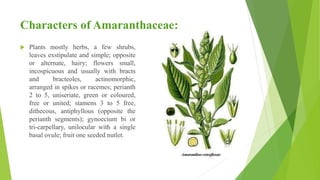amaranthaceae-210707061148.pdf
•
0 recomendaciones•30 vistas
Hi
Denunciar
Compartir
Denunciar
Compartir
Descargar para leer sin conexión

Recomendados
Más contenido relacionado
Similar a amaranthaceae-210707061148.pdf
Similar a amaranthaceae-210707061148.pdf (20)
Gramineae (poaceae).it is the one of the largest plant family

Gramineae (poaceae).it is the one of the largest plant family
Más de Mohitgupta555351
Más de Mohitgupta555351 (6)
comparative_Nervous_Syst_Vertebrate_Life_Sciences_1yr_PDF.pdf

comparative_Nervous_Syst_Vertebrate_Life_Sciences_1yr_PDF.pdf
Último
Último (20)
Measures of Central Tendency: Mean, Median and Mode

Measures of Central Tendency: Mean, Median and Mode
Role Of Transgenic Animal In Target Validation-1.pptx

Role Of Transgenic Animal In Target Validation-1.pptx
Asian American Pacific Islander Month DDSD 2024.pptx

Asian American Pacific Islander Month DDSD 2024.pptx
Beyond the EU: DORA and NIS 2 Directive's Global Impact

Beyond the EU: DORA and NIS 2 Directive's Global Impact
Micro-Scholarship, What it is, How can it help me.pdf

Micro-Scholarship, What it is, How can it help me.pdf
Seal of Good Local Governance (SGLG) 2024Final.pptx

Seal of Good Local Governance (SGLG) 2024Final.pptx
Presentation by Andreas Schleicher Tackling the School Absenteeism Crisis 30 ...

Presentation by Andreas Schleicher Tackling the School Absenteeism Crisis 30 ...
General Principles of Intellectual Property: Concepts of Intellectual Proper...

General Principles of Intellectual Property: Concepts of Intellectual Proper...
Z Score,T Score, Percential Rank and Box Plot Graph

Z Score,T Score, Percential Rank and Box Plot Graph
Energy Resources. ( B. Pharmacy, 1st Year, Sem-II) Natural Resources

Energy Resources. ( B. Pharmacy, 1st Year, Sem-II) Natural Resources
Basic Civil Engineering first year Notes- Chapter 4 Building.pptx

Basic Civil Engineering first year Notes- Chapter 4 Building.pptx
Measures of Dispersion and Variability: Range, QD, AD and SD

Measures of Dispersion and Variability: Range, QD, AD and SD
Ecological Succession. ( ECOSYSTEM, B. Pharmacy, 1st Year, Sem-II, Environmen...

Ecological Succession. ( ECOSYSTEM, B. Pharmacy, 1st Year, Sem-II, Environmen...
amaranthaceae-210707061148.pdf
- 1. Characters of Amaranthaceae: Plants mostly herbs, a few shrubs, leaves exstipulate and simple; opposite or alternate, hairy; flowers small, incospicuous and usually with bracts and bracteoles, actinomorphic, arranged in spikes or racemes; perianth 2 to 5, uniseriate, green or coloured, free or united; stamens 3 to 5 free, dithecous, antiphyllous (opposite the perianth segments); gynoecium bi or tri-carpellary, unilocular with a single basal ovule; fruit one seeded nutlet.
- 2. A. Vegetative characters: Habit: Mostly herbs, rarely shrubs or undershrubs (Deeringia), annual or perennial (Bosia, Ptilotus). Root: A branched tap root. Stem: Aerial, herbaceous or woody, erect or straggling, cylindrical, or angular, branched, solid, hairy, green or striped green. Leaves: Simple, alternate or opposite, petiolate, exstipulate, reddish in colour, unicostate reticulate venation.
- 3. B. Floral characters: Inflorescence: Axillary or terminal spikes (Achyranthes, Digera). Some times in cymose panicles. Flower: Bracteate, sessile or sub-sessile, bracteolate, bracteoles two, actinomorphic, hermaphrodite or unisexual hypogynous, small inconspicuous, green or variously coloured. Perianth: Usually five tepals, free or united, sometimes two or three (Amaranthus), dry membranous, valvate or twisted, sometime, hairy, green or coloured, persistent, inferior.
- 4. Androecium: Stamens 5 or 3 (Amaranthus), free or united, staminodes sometimes present, introrse, dithecous or monothecous (Alternanthera). In Achyranthes 5 fimbriated scales alternate with 5 fertile stamens. Gynoecium: Bicarpellary, or tricarpellary; syncarpous, ovary superior, unilocular, usually one campylotropous ovule; basal placentation; style short or filiform; stigma 2 or 3. Fruit: Dry one seeded achene or several seeded capsule or one to several seeded berry. Seed: Endospermic with polished testa, kidney-shaped embryo curved. Pollination: Mostly anemophilous and in some plants entomophilous.
- 5. Floral formula: Floral diagram: Floral diagram of Amaranthaceae
- 6. Distribution of Amaranthaceae: The family Amaranthaceae is commonly called ‘Amaranth family’. It is a small family comprising 65 genera and 850 species which are chiefly represented in tropical and temperate regions. In India it is represented by 50 species. Economic Importance of Amaranthaceae: The Amaranthaceae is of little economic importance. Food: Seeds of Amaranthus caudatus are edible. Amaranthus cruentus and A. frumentacea are raised as cereals by primitive tribes in Tropical Asia. The leaves of Amaranthus viridis, A. spinosus and A. tricolor are also used as vegetables. Medicinal: Achyranthes aspera is diuretic and purgative. Decoction of Aerua tomentosa is used to remove swellings. The stem and leaves of Alternanthera are used in snake-bite. The flowers and seeds of Digera muricata (syn. D. arvensis) are given for urinary discharges.
- 7. Dye: Leaves of Bosia amherstiana yield a black dye. The fruit juice of Deeringia is a substitute for red ink. Weeds: Some genera are weeds e.g. Amaranthus, Celosia, Digera, Achyranthes, Gomphrena etc. Ornamentals: Celosia cristata (Cockscomb), Gomphrena globosa (Globe amaranthus) are cultivated in gardens. Primitive characters: Plants under-shrubs or shrubs (Bosia, Ptilotus). Leaves simple and alternate. Flowers actinomorphic, hypogynous and hermaphrodite. Anthers dithecous. Seeds endospermic.